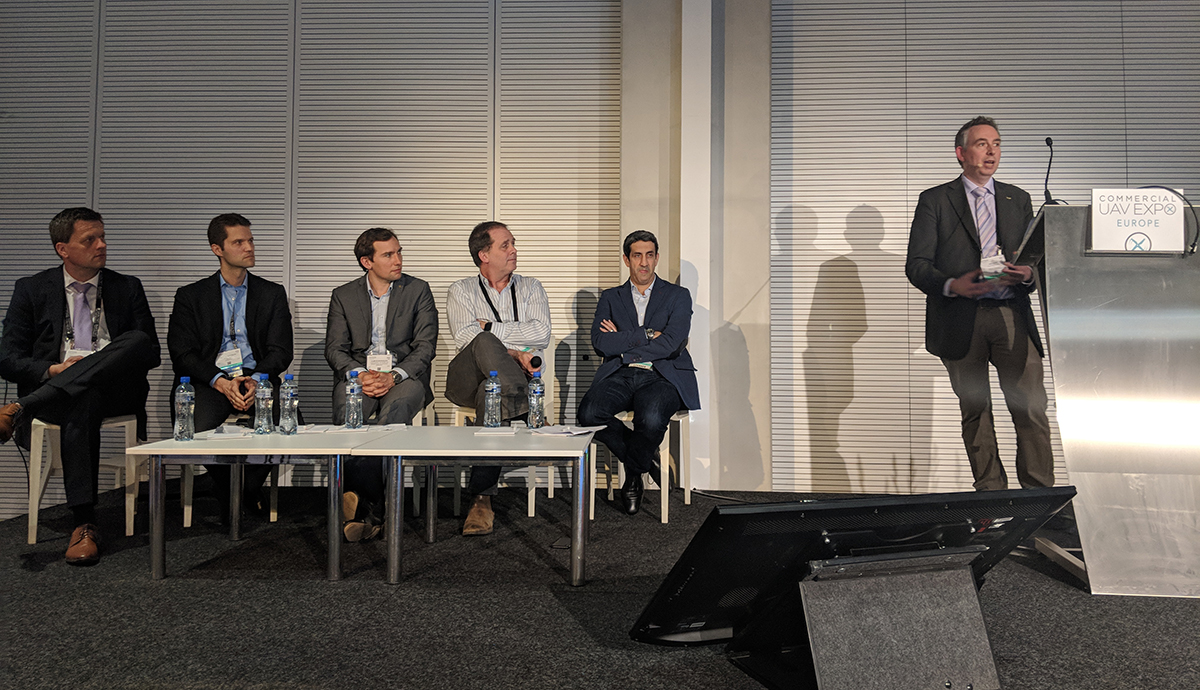On the first day of
Commercial UAV Expo Europe, we attended an important session entirely dedicated to the issue of Safety and Risk Management. The panel included Eden Attias from ParaZero, Steve Flynn from Skytango, Oliver Heinrich from BHO Legal, Ulrich Hoffman from Lufthansa Technik and Thomas Kriesmann representing the insurance giant Allianz.
The session was masterfully moderated by Neil Kidd from Altitude Angel, who opened the discussion by asking the panelists to introduce themselves and then invited the attendees to bring topics to the floor for discussion.
The first question was about the lessons we can learn from manned aviation, so we don’t make the same mistakes. Ulrich took the microphone and made a compelling case for safety.
“Unless the UAV industry behaves in a way that preserves the current standards of safety for the flying public and people on the ground, the applications will be limited and legislative advancement slow," Ulrich said. Neil intervened to say that drone companies should aim to obtain the safety record of manned commercial operators and not the private general aviation (GA) group. Steve mentioned that the perception amongst the public is that drone pilots are careless and that creates mistrust with regulators and commercial operators alike.
One person in the audience asked the panelists to compare progress being made between driverless cars and autonomous UAVs. Eden took control of the discussion by saying that today, manned aviation is highly automated and pilots are there just in case of emergencies.
“Technology today allows for commercial aircraft to fly 99% of the time while en route completely autonomously, with pilots playing more of a ‘supervisory’ role in emergency situations," Thomas said. "We will first see autonomous aerial taxis in places like Dubai, then witness driverless cars in the USA or Europe.” He gave the example of pedestrians as an illustration of major obstacles to driverless vehicles. “In the air, every object is potentially tracked, but pedestrians will never be in a network.”
A question was asked about the issues that drone pilots should be aware of before taking photographs from the air. Steve explained that the same standards of non-aerial photographs should be applied to any data acquired from the air. “There’s no difference when it comes to intellectual property rights and privacy. A photo is a photo and you better not use images that are not yours or that expose privacy concerns.”
Ulrich agreed and emphasized that we have had regulations for still photography and video for over 70 years and the standards are the same. Thomas got everyone thinking about the insurance angle by explaining that coverage for your drone might not cover violations of privacy and wrong usage of data “An invasion of privacy is not an accident and the insurance industry will not cover it.”
That comment created some heated discussions amongst the attendees who asked for clarification, and Thomas needed to further explain the point.
“In general terms, we insure the aircraft and in some cases the cameras, but at no point can we insure the misuse of the data acquired.” He made a strong case for reading the fine print of your drone insurance policy. Ulrich intervened to say that because drones are now taking photographs and video from a certain altitude and capturing images that might be subject to privacy concerns, the authorities are paying more attention to use and misuse of UAVs and that the industry is attracting unwanted attention for the actions of a few “bad actors”.
Thomas made a point of explaining that the insurance industry was also new to the issues raised by drones and the gargantuan amount of data being captured daily. “We’re all learning together how to deal with this new technology and I strongly recommend that you negotiate and bring ideas to your insurance broker. The industry is eager to learn and be useful.”
One member of the audience was given the opportunity to ask the last question of the session and she asked the panelists about the short-term issues they were most excited about or more worried about.
Eden mentioned that the technology will play a crucial role in mitigation and recovery from disasters and that was an area he was particularly excited about. He added that drones are becoming more and more reliable, and following this trend was very exciting. He expressed concerns about bad actors.
Steve was a bit less optimistic when he said that he was worried about the proliferation of drone users and the potential exposure to liabilities that these people will bring to the table; he also forecasted that the industry will see a lot of consolidation over the next few years.
Ulrich praised EASA, the European Aviation Safety Agency for its efforts to implement a pan-European set of rules and a
coherent UTM system that can be adopted seamlessly throughout the continent.
Neil closed the session by thanking the audience for their participation and after, a large number of attendees flocked to Thomas to talk about insurance, which was further proof of just how many people are focused on this topic and how it will impact the future of the commercial UAV industry.















Comments